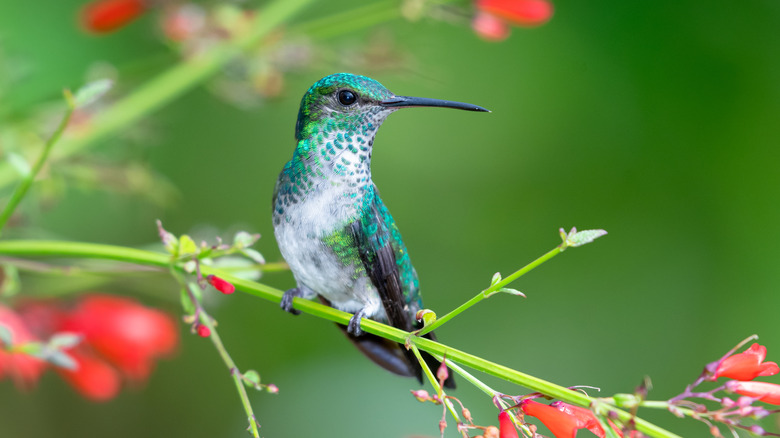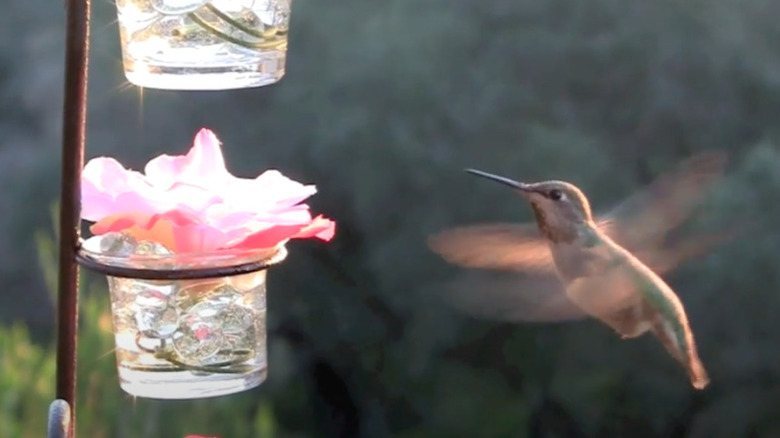The Harmful Method For Attracting Hummingbirds That You Need To Avoid
The benefits of attracting hummingbirds to your yard are not to be pecked at. They pollinate flowers, help keep backyard bug populations in check, and are an indicator of ecosystem health. If you're not spotting any of these winged jewels in your yard, you might be tempted to attract them by hanging a few baskets of vibrant plastic salvia or petunia. Fake flowers on their own offer zero benefit to hummingbirds — nor to any backyard visitors, for that matter. Despite beckoning the birds over with their siren call of bloom shape, size, and color, they don't offer up any food. Teeny hummers may also get tangled in the strings and netting that prop up faux bouquets. There are, however, responsible ways to use floral imitations in your hummingbird attractions endeavors. Simply put, use them sparingly and always pair them with nectar.
Backyard birders who use artificial flowers to attract hummingbirds believe that the bright colors grab the flying gems' attention. In fact, hummer experts consider the idea of bloom hue as an attractant to be inconclusive at best. Hummingbirds use various ways to choose which flowers to visit (and re-visit), including flower shape, and a surprisingly excellent visual memory to remember which food sources are worth revisiting because they have the most nectar and even how long it takes a particular plant to replenish its nectar supply. Artificial flowers are often used in hummingbird research, but they're always paired with nectar.
Why faux flowers might equal trouble for hummingbirds
Hummingbirds rarely visit a flower twice if it doesn't yield a reward — that is, tasty nectar. What's more, a 2001 study published in Ornithology found that hummers have to work harder to investigate new food sources than visit old ones. The wee feathered avians are eating machines; a single hummer visits upwards of 2,000 flowers a day and can only rest about 15 minutes between feedings. If they're constantly checking out flowers sans nectar, it strains their energy reserves. A few pots of artificial flowers dotted around a yard full of real blooms and bird feeders are probably okay. But if faux florets are the only option, this could be a problem, at least for a resource-depleted hummer visiting for the first time.
Practically, the beautiful hummingbirds you might find in your backyard could get tangled in artificial flower arrangements. Faux wreaths, garlands, and shrubs in planters are assembled using fine wire, floral netting, and string, which can snag a curious or startled bird. It's not really an issue for hummers, but other birds may try to eat pretend fruit, berries, nuts, or seeds, thinking they're real. Plus, a yard full of bogus flowers (and non-native plants, for that matter) has similar downsides to one covered in artificial turf, especially in urban environments. As natural ecosystems rich with real flowers shrink, there are fewer places for hummingbirds — and all kinds of other wildlife — to feed, rest, and complete their life cycles.
Can you responsibly use artificial flowers to entice hummingbirds?
There's a reason the nectar pots on so many commercial hummingbird feeders are flower-shaped! If you still want to use artificial flowers, the key is to use them sparingly and always pair them with nectar. The hummers will quickly associate the faux flowers with a sweet treat. This could be as simple as tying a few bright plastic flowers to the pole your hummingbird feeder is perched on or near the receptacles. Use heavy gauge wire to reduce the risk of entanglements. You could also add sugar water receptacles to fake flower pots, or make a simple tabletop hummingbird feeder by filling a shot glass with some fresh homemade sugar water or store-bought nectar and a few silk blooms in vibrant hues.
Better yet, ditch the artificial florets in favor of real blooms. Backyard bird experts note that hummingbirds are unlikely to stick around a yard devoid of actual flowering plants, even if your artificial blooms come with sweet rewards. Dense privacy shrubs full of tubular flowers are perfect for hummingbirds because they offer both the right-shaped buds to attract them and safe nesting locations. Rosette-shaped blooms work, too. Horticultural societies and college extension programs publish lists of hummingbird-friendly plants that are local to the state. For example, this hummingbird-friendly plant list from Iowa State University's Yard and Garden website or the Hummingbird Plant List from UC Davis Arboretum and Public Garden.

